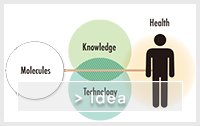Technologies of CLST
SINEUPs: A new class of translation regulating RNA
SINEUP is a class of novel non-coding RNAs (ncRNAs), which was reported in 2012(Nature. 491:454-7.2012). Since they can be used as a tool to stimulate protein translation of mRNA of interest, broad applications of it is expected from research reagent to therapeutic. They are composed with Effector Domain(ED) and Biding Domain(BD). ED is the domain that has function of stimulation of protein translation and BD is the domain designed specifically binds target mRNA.
RNAi is emerging market accumulating global attention. in contrast with RNAi, SINEUP is functioning opposite direction. RNAi inhibits gene expression through biding target mRNA followed by degradation process. SINEUPs enhance protein translation. RNAi can be a powerful tool in case that inhibition of responsible protein through inhibition of its mRNA. However, it cannot cure diseases that are caused by insufficient protein production. On the contrary, SINEUPs are the tools needed to approach these unmet medical needs.
For example, in haploinsufficiency one allele is not being expressed , often because mutated. Consequently, amount of the protein is insufficient. Several diseases are caused by such insufficient amount of the protein. Also, some unhealthy status can be caused by insufficient amount of required protein. SINEUP has potential to improve these conditions.
Some of reports estimate the market of RNAi would be reaching 241 million dollars. However, almost all of fundamental patents and intellectual properties are owned mainly by US companies. Japan is so behind them in terms of IP and commercialization. Even major Japan pharmaceuticals have to spend huge amount of money for licensing and/or collaboration. We aim to establish core platform of next generation biomedical made in Japan, based on SINEUP.
SINEUP needs to be designed specifically for target. Now, we are building up platform for SINEUP design, more effectively. Applying this SINEUP platform to various disease related gene, we will establish SINEUP basis therapy.

Figure1.
SINEUP is composed with Effector Domain (ED) and Biding Domain (BD). ED is the domain that has function of stimulation of protein translation and BD is the domain designed specifically binds target mRNA.
REFERENCES
Long non-coding antisense RNA controls Uchl1 translation through an embedded SINEB2 repeat,
Carrieri C, Cimatti L, Biagioli M, Beugnet A, Zucchelli S, Fedele S, Pesce E, Ferrer I, Collavin L, Santoro C, Forrest AR, Carninci P, Biffo S, Stupka E, Gustincich S. Nature. 2012 Nov 15;491(7424):454-7.
Zucchelli S, Cotella D, Takahashi H, Carrieri C, Cimatti L, Fasolo F, Jones MH, Sblattero D, Sanges R, Santoro C, Persichetti F, Carninci P, Gustincich S.
RNA Biol. 2015;12(8):771-9.
Patrucco L, Chiesa A, Soluri MF, Fasolo F, Takahashi H, Carninci P, Zucchelli S, Santoro C, Gustincich S, Sblattero D, Cotella D.
Gene. 2015 Sep 15;569(2):287-93.
Zucchelli S, Fasolo F, Russo R, Cimatti L, Patrucco L, Takahashi H, Jones MH, Santoro C, Sblattero D, Cotella D, Persichetti F, Carninci P, Gustincich S.
Front Cell Neurosci. 2015 May 13;9:174.
Widespread genome transcription: new possibilities for RNA therapies,
Takahashi H, Carninci P, Biochem Biophys Res Commun. 2014 Sep 19;452(2):294-301.















